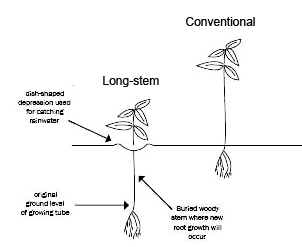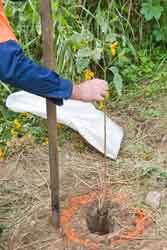Submitted by : Anna Bourke/Charles Ivin Date Posted: 16 September 2011
 |
| Difference of long-stem from conventional planting (Australian Plants Society) |
There is a growing interest in the use of 'long-stem' planting of native plants in connection with revegetation practices. This news item gives some basic information about it. The following is mainly extracted from an Australian Plants Society Guide, 'The Long-stem Planting Guide', downloadable from their site. It is based mainly on the pioneering work of Bill Hicks in the Hunter Valley.
The long-stem planting method is an innovative way of planting that can result in higher survival and growth rates with minimal post-planting care. With the use of the long-stem method, seedlings are grown in pots for 10-18 months, so that they develop long woody stems. These seedlings are then planted with about three-quarters of their length below the soil surface, approximately one metre deep, which results in much of the woody stem being covered with soil. (See the diagram right). The deep planting protects the roots from substantial changes in soil temperature, allows the plant access to deeper soil moisture and reduces competition from weeds.
 |
| Long-stem eucalypt plant being placed in prepared hole at Osborne Road site (Yellow Japanese Sunflower weed behind) |
Once planted, the seedling develops roots from the buried stem and leaf nodes. This promotes the development of a robust root network which gives the seedling a greater chance of survival. Since most of the seedling's woody stem is planted underground, it is uncertain why this method of planting does not subject the stems to enhanced disease and fungal attack. Although increased planting success rates suggest this is not a problem, further research is needed to explain why.
Field trials using the long-stem method have included a variety of native species to demonstrate that seedlings can have survival and growth rates that exceed those planted using traditional planting methods. Furthermore, successful trials on river banks have been repeated under saline and also sand dune environments.
A trial of native long-stem planting has begun at the Osborne Road Bushcare Group site at Everton Park. Previously over 2010-2011, KBCB had a couple of unsuccessful attempts to secure funding for such a project. Then, Brisbane City Council’s Habitat Team in collaboration with Habitat Brisbane, came to the rescue and provided the labour and materials to start the trial of native long-stem planting – a first as far as we know for South East Queensland. The Habitat Team, along with seven trainees called the Green Troops, spent a few big days in July-August 2011 preparing the site in and planting twelve of each (120 trees) from the mix of ten specially raised tree species.
This work has helped to re-establish vital native cover for this section of the Brook consequent to the large scale engineering works undertaken to halt erosion of the housing properties opposite. Furthermore, if it is demonstrated to be successful, the native long-stem planting technique could herald a new era in planting in dynamic riparian areas and dealing with erosion issues. KBCB will continue to provide updates in terms of species successes and failures as the project progresses.
(Anna Bourke/CI) 16/09/2011
CI 14/08/2012

